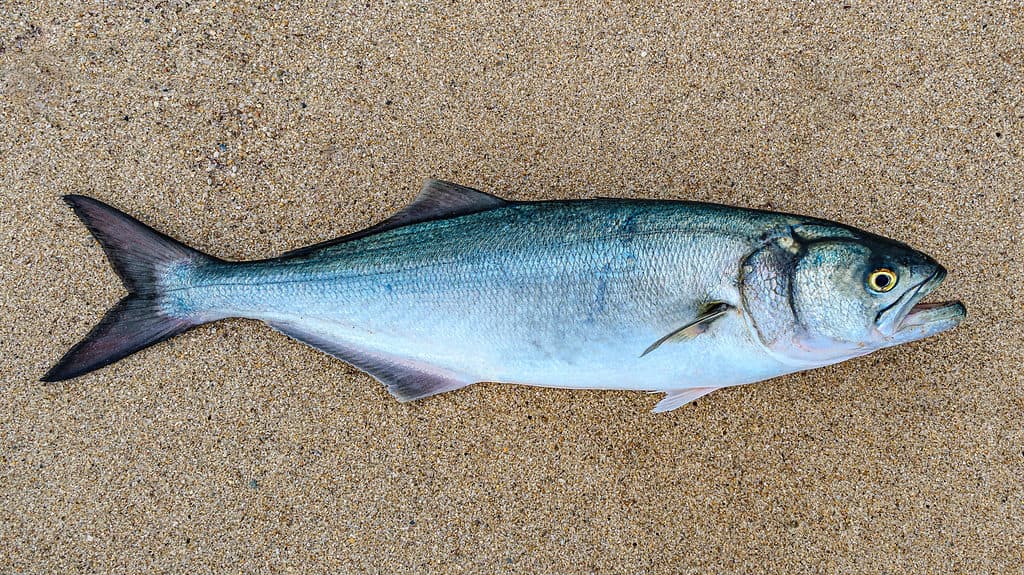There is some disagreement among anglers when it comes to bluefish. While some love how fiercely they fight and how they taste when either smoked or grilled, others wouldn’t even pick up a fork to give them a go. Similarly, those who aren’t fans of bluefish don’t put forth the effort to catch them. They may see them more as a nuisance, especially when they bite right through the bait. However, that doesn’t stop those who appreciate bluefish from going for them. There are several bluefish records throughout the world, but below, we highlight the largest bluefish ever caught in Louisiana.
What Are Bluefish
Bluefish go by other names, including elfs, choppers, tailors, snappers, and baby blues. These migratory fish swim across the Atlantic from the northern state of Maine down to the southern state of Florida. They move every season, and they make up a market primarily for human consumption. They are sustainably overseen and responsibly collected in accordance with U.S. regulations. Bluefish also live in other places throughout the world, including the Gulf of Mexico and the Indian and South Pacific oceans.
You can identify bluefish by their colors. On their sides and belly is a silvery color, and on their backs, the coloration is more of a blue-green. Their jaws are prominent, and their teeth aren’t just sharp, but they’re also tightly pressed together. A bluefish’s lifespan is up to 12 years. Their growth rate is fast. They can grow as big as 39 inches long and weigh as much as 31 pounds. Once they’re about two years old, they’re already somewhere between 15 and 20 inches long. This is when they start reproducing.
The females can produce anywhere between 400,000 and 2 million eggs at a time (depending on how big she is). When they feed, they exhibit intense behavior. They work as a team in large schools to take down bait fish closer to the water’s surface. Their ravenous frenzy, referred to as the “bluefish blitz,” makes so much commotion, it’s like the point where a waterspout touches the water. Juvenile bluefish may fall prey to oceanic birds, but usually, they make squid and smaller fish their prey.
When bluefish reach adulthood, they’re no longer of interest to oceanic birds. Still, there are some predators big and fast enough to snatch them up, like sharks and tunas. Bluefish prefer warm water and so make inshore and offshore areas their home, either north or south, depending on where the weather is more favorable.

The bluefish is a blue-green shade.
©John Piekos/Shutterstock.com
Bluefish Fishing Basics
When fishing for bluefish, you first have to pick a prime warm water location — think temperatures between (upper) 50°F and 80°F. The schools of baitfish lead you to where the schools of bluefish are, so your time is better spent looking for the baitfish first. They can typically be found around cuts in sandbars or at different points along the beach. If you’re not already familiar with reading the beach, this process will get you acquainted. If you spot baitfish and they’re jumping, head on over because they’re trying to escape bluefish, scooping them up from below the surface.
In terms of lures, use something shiny. Topwater baits are ideal. For example, you can use a silver spoon. This is a popular lure that has a high success rate. Don’t let it sit, however; it attracts more attention with swift, continuous movements. For the topwater bait, opt for a “walk the dog” style, which copies the movements of a wounded bait fish. Keep in mind when preparing your bait that bluefish chomp down, so larger bait isn’t a good idea. Finally, when you’ve got your catch, don’t forget about their razor-sharp teeth. Handle it with care and use pliers to remove the hook.
The Largest Bluefish Ever Caught In Louisiana
The largest bluefish ever caught in Louisiana weighed a total of 21.88 pounds. Steve Van Every caught it in July of 1982. The exact location is unknown, but he kept the number one spot, even after Jerry Quick brought in an 18-pound bluefish in June of 1984. The third and fourth place holders brought in bluefish that weighed just over 16 pounds the same year in March and September of 1971.
Even though these bluefish catches made state records, the world record is held by James Hussey, who was fishing out at the Hatteras Inlet in North Carolina. It was January 1, 1972, and he was using plastic eels when he felt the powerful chomp. It was a 15-minute-long fight before he was able to get that bluefish onto his boat. When all was said and done, that bluefish weighed an impressive 31 pounds and two ounces.
Where Is Louisiana Located On A Map?
Louisiana is located in the southern part of the United States. It is bordered by Texas to the west, Mississippi to the east, Arkansas to the north, and the Gulf of Mexico to the south. Arcadia is located in the northern part of the state, between Monroe and Shreveport.
The photo featured at the top of this post is © iStock.com/FtLaudGirl
Thank you for reading! Have some feedback for us? Contact the AZ Animals editorial team.







